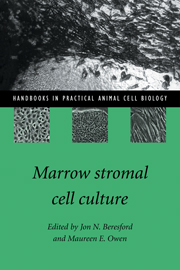Book contents
- Frontmatter
- Contents
- List of contributors
- Preface to the series
- Preface
- 1 The marrow stromal cell system
- 2 The bone marrow stroma in vivo: ontogeny, structure, cellular composition and changes in disease
- 3 Isolation, purification and in vitro manipulation of human bone marrow stromal precursor cells
- 4 Isolation and culture of human bone-derived cells
- 5 Marrow stromal adipocytes
- 6 Osteoblast lineage in experimental animals
- 7 Chondrocyte culture
- 8 Osteogenic potential of vascular pericytes
- Index
6 - Osteoblast lineage in experimental animals
Published online by Cambridge University Press: 20 January 2010
- Frontmatter
- Contents
- List of contributors
- Preface to the series
- Preface
- 1 The marrow stromal cell system
- 2 The bone marrow stroma in vivo: ontogeny, structure, cellular composition and changes in disease
- 3 Isolation, purification and in vitro manipulation of human bone marrow stromal precursor cells
- 4 Isolation and culture of human bone-derived cells
- 5 Marrow stromal adipocytes
- 6 Osteoblast lineage in experimental animals
- 7 Chondrocyte culture
- 8 Osteogenic potential of vascular pericytes
- Index
Summary
Introduction
Scope of the chapter
Understanding the origin and differentiation of osteoprogenitors (OPC) has been hampered by the fact that unequivocal criteria for their identification have not been established, that they are relatively rare cells and that insufficient information is available on the differentiation stages through which they progress in becoming mature osteoblasts. Given that direct identification has been difficult, indirect functional and colony assays have been used to determine OPC, based on their capacity to produce recognisable differentiated progeny (osteoblasts) capable of forming a tissue that histologically and biochemically resembles bone (Aubin, Turksen & Heersche, 1993).
Friedenstein and colleagues were the first to demonstrate that bone marrow stroma contains cells with the capacity to form bone when transplanted in vivo in a diffusion chamber (references in Owen, Chapter 1). More recently, conditions have been determined in which bone formation can occur and be manipulated in vitro in cell populations derived from bone and the marrow stroma. The aim of this chapter is to describe the methodology currently in use in the authors' laboratory for the investigation of the differentiation of OPC in primary cultures of animal bone and marrow cell populations.
Historical perspective
The first report that cells isolated from the bones of fetal or neonatal rodents were able to form a bone-like tissue in vitro was made in the early 1980s in a number of laboratories (for review, see Aubin, Turksen & Heersche, 1993).
- Type
- Chapter
- Information
- Marrow Stromal Cell Culture , pp. 88 - 110Publisher: Cambridge University PressPrint publication year: 1998
- 12
- Cited by



